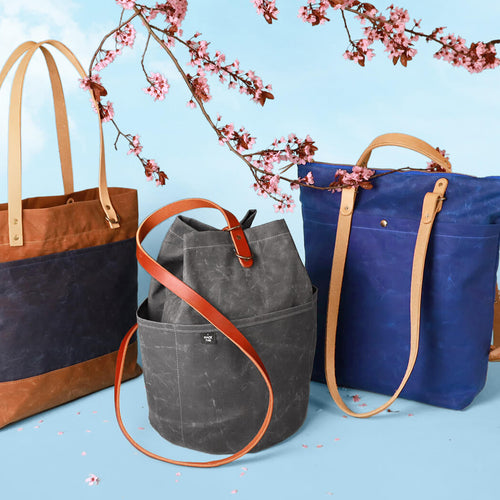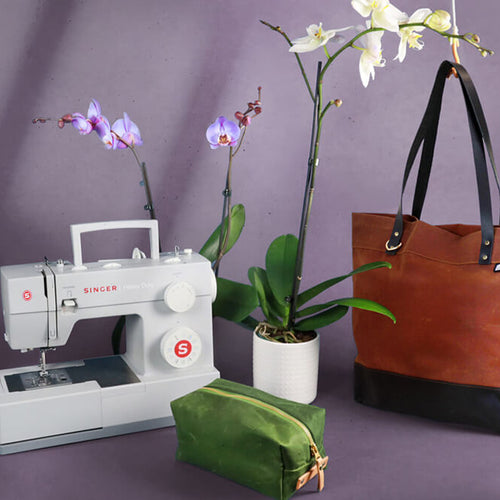
Klum House kits come with fully-prepped leather pieces, so all you have to do is attach them, but if you’re down to learn some new skills, you can totally take strap-making into your own hands! Below is a list of essential tools for creating leather straps, either from a full hide or from pre-cut leather strips. With a little practice and the right tools, you’ll be processing leather for all of your own bag making projects in no time!
_________________________________________________________________________________________________________________
LEATHER STRAPS TOOL KIT
If you’d like a little head start, our Leather Straps Tool Kit comes with several of these tools bundled at a discounted price! It contains a mallet, a cutting board, an 1/8” drive punch, a 3/4” round end punch, and a leather marking pen.
_________________________________________________________________________________________________________________
LEATHER STRAP CUTTER
A leather strap cutter is used to cut strips from a full hide of leather. Its has an adjustable blade that allows you to set the exact size of your desired strap width. This tool takes a little kinetic learning, getting your body accustomed to the movement, but once you get the hang of it you’ll wonder how you ever survived without it! Even for an experienced leatherworker, it can be challenging to get an even, straight cut on a hide without a leather strap cutter. If you’d like to give it a go, we recommend using a super sharp rotary cutter, self-healing cutting mat, and a long quilting ruler with an anti-slip back.




_________________________________________________________________________________________________________________
LEATHER STRIPS
Purchasing a full leather hide can be quite expensive and not every bag maker needs THAT many straps. Alternatively, it might make more sense to purchase pre-cut leather strips, which you can then cut down to any length to suit your needs. Our leather strips come in a variety of widths ( ¾", 1", 1 ¼") and are between 80”-100” in length. When purchasing pre-cut leather strips, make sure to pay attention to the thickness, or “weight”, of the leather. Different leather comes in different weights. For example, the leather we use for our Slabtown Backpack is thicker at 9-10 oz than the leather tote straps on our Portsmith or Oberlin Totes, which are 6-8 oz.
_________________________________________________________________________________________________________________
BAKELITE MALLET
Every bag maker's tool kit should include a high-quality, heavy-duty mallet. Whether you’re striking punching tools, setting rivets, or embossing leather with stamps, a mallet will be your trusty friend. When it comes to strap making, a mallet is used to punch holes for future hardware installation and to create nicely rounded strap ends with a round strap end punch. Keep in mind, all mallets are not created equal! Avoid using a rubber mallet, as they tend to bounce and don’t go a great job of transferring the force of your strike. Similarly, a metal hammer will bounce off your metal tool—and might damage it in the process! Our favorite is this Bakelite Mallet, which has a solid poly head for transferring force, a large surface area, and is just the right weight.
_________________________________________________________________________________________________________________
DRIVE PUNCH OR ROTARY PUNCH
When making straps, you'll often need to punch holes in your leather for setting rivets or other hardware. There are two options for doing punching holes in leather: (1) Use a hand-squeeze rotary punch, which has a barrel that rotates to select different punch sizes. (2) Use a drive punch of the correct size with a mallet on top of a cutting board. In either case, be sure to punch the correct sized hole for the hardware you are using. If you’re not sure which size hole to punch, hold your hardware post up to the punching tool to compare sizes. When in doubt, start a little smaller, because you can always size up! You want the post to fit in the hole snugly, without wiggle room.

Rotary Punch with Easy Squeeze Assist Drive Punches
_________________________________________________________________________________________________________________
POLY PUNCHING + CUTTING BOARD
When working with punching or cutting tools, you'll need protection under your work to preserve your work surface and keep your tools sharp. Leatherwork cutting boards should be soft enough to allow tools to bit into them and thick enough that the tool will not pierce through. We love this small poly punching + cutting board. It’s even self-healing, so it can hold up to a lot of wear and tear.Warning:Don’t use a drive punch directly on your cutting mat, or you will make a hole in your cutting mat, and maybe even your table!
_________________________________________________________________________________________________________________
ROUND STRAP END PUNCH
Okay, so a round strap end punch is not 100% necessary—you can always cut straight strap ends with a rotary cutter—but if you want to soften those edges, a round strap end punch will help elevate your straps to the next level. End punches come in different shapes. Round end punches are the most common, but you can also find an English point end punch, which is basically a rounded V-shape. They also come in different widths. You’ll typically want to match the width of the end punch to the width of your strap (i.e. 3/4” strap = 3/4” end punch). However, if the end punch is slightly wider than the strap, it will do just fine. For example, you could use a 1 ½” punch on a 1 1/8” strap (like the Slabtown Backpack straps!) if the exact size is not available. We suggest purchasing a 1 ½” end punch for straps that are 1-1 ½” wide and a ¾” punch for straps ¾” wide and thinner.

_________________________________________________________________________________________________________________
LEATHER MARKING PEN
LEATHER MARKING PEN
This little leather marking pen is the best we’ve found for creating easy-to-see, impermanent marks on leather. Other pens like gel or ink pens will permanently mark leather while the ink of this pen can easily be wiped away. Plus, the silver ink shows up on both dark and light-colored leather.
_________________________________________________________________________________________________________________
WANT TO LEARN MORE?
Check out this video tutorial, where Ellie shows you step-by-step how to make leather straps!
WANT TO LEARN MORE?
Check out this video tutorial, where Ellie shows you step-by-step how to make leather straps!









